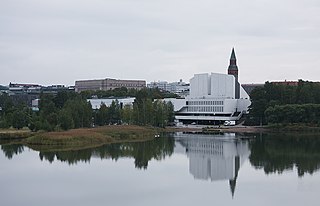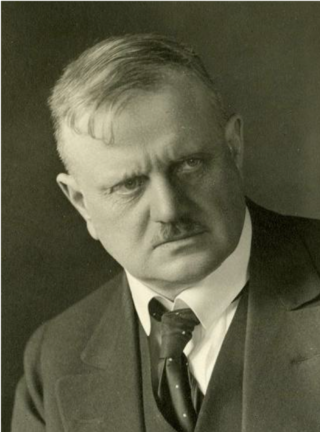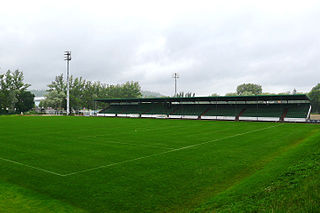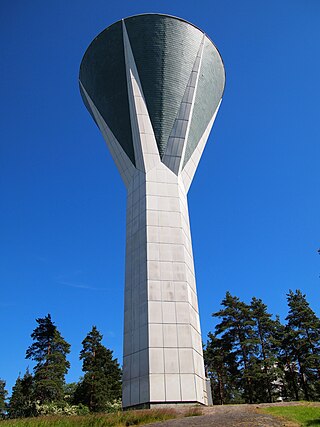
The Royal Concertgebouw is a concert hall in Amsterdam, Netherlands. The Dutch term "concertgebouw" translates into English as "concert building". Its superb acoustics place it among the finest concert halls in the world, along with Boston's Symphony Hall and the Musikverein in Vienna.

Lahti is a city in Finland and the regional capital of Päijät-Häme. It is located in the Finnish Lakeland. The population of Lahti is approximately 121,000, while the sub-region has a population of approximately 205,000. It is the 9th most populous municipality in Finland, and the sixth most populous urban area in the country.

Jukka-Pekka Saraste is a Finnish conductor and violinist.

Finlandia, Op. 26, is a tone poem by the Finnish composer Jean Sibelius. It was written in 1899 and revised in 1900. The piece was composed for the Press Celebrations of 1899, a covert protest against increasing censorship from the Russian Empire, and was the last of seven pieces performed as an accompaniment to a tableau depicting episodes from Finnish history. The premiere was on 2 July 1900 in Helsinki with the Helsinki Philharmonic Society conducted by Robert Kajanus. A typical performance takes between 7½ and 9 minutes depending on how it is performed.

The Finlandia Hall is a congress and event venue in the centre of Helsinki on the Töölönlahti Bay, owned by the City of Helsinki. The building, which was designed by architect Alvar Aalto, was completed in 1971. Every detail in the building is designed by Aalto. The designs were completed in 1962, with building taking place between 1967 and 1971. The Congress Wing was designed in 1970 and built in 1973–1975. In 2011, the building was expanded with new exhibition and meeting facilities. Finlandia Hall is known as the venue for the OSCE Summit held in August 1975, attended by 35 world leaders, including the leader of the Soviet Union, Leonid Brezhnev, and the President of the United States, Gerald Ford.

En saga, Op. 9, is a single-movement tone poem for orchestra written from 1891 to 1892 by the Finnish composer Jean Sibelius. The piece, which likely began as a septet or octet for flute, clarinet, and string ensemble before evolving into an orchestral tone poem, premiered on 16 February 1893 in Helsinki with Sibelius conducting the Helsinki Orchestral Association. A decade later in 1902, Sibelius substantially revised En saga in response to an invitation from Ferruccio Busoni to conduct the piece in Berlin. It thus stands alongside The Lemminkäinen Suite (Op. 22), the Violin Concerto (Op. 47), The Oceanides (Op. 73), and the Fifth Symphony (Op. 82) as one of the most overhauled works in his œuvre. The Berlin concert, which occurred a fortnight after Robert Kajanus had premiered the revised version in Helsinki on 2 November, finally brought Sibelius the German breakthrough he had long desired.

The Oceanides, Op. 73, is a single-movement tone poem for orchestra written from 1913 to 1914 by the Finnish composer Jean Sibelius. The piece, which refers to the nymphs in Greek mythology who inhabited the Mediterranean Sea, premiered on 4 June 1914 at the Norfolk Music Festival in Connecticut with Sibelius conducting. Praised upon its premiere as "the finest evocation of the sea ... ever ... produced in music", the tone poem, in D major, consists of two subjects, said to represent the playful activity of the nymphs and the majesty of the ocean, respectively. Sibelius gradually develops this material over three informal stages: first, a placid ocean; second, a gathering storm; and third, a thunderous wave-crash climax. As the tempest subsides, a final chord sounds, symbolizing the mighty power and limitless expanse of the sea.
The Lahti Symphony Orchestra is a Finnish orchestra, based in the city of Lahti. The orchestra is resident at the Sibelius Hall. The orchestra was founded in 1910, and placed under the control of the Lahti municipality in 1949.

Temppeliaukio Church is a Lutheran church in the Töölö neighbourhood of Helsinki, Finland. The church was designed by architects and brothers Timo and Tuomo Suomalainen and opened in 1969. Built directly into solid rock, it is also known as the Church of the Rock and Rock Church.

Lilli Katriina Paasikivi-Ilves is the artistic director of the Finnish National Opera since 2013 and a mezzo-soprano.

Kalevi Ilmari Kiviniemi was a Finnish concert organist. He gave more than 2,000 concerts, and his discography includes nearly 200 titles, many of them featuring significant and unique organs in the US, Japan, the Philippines, Australia, Italy, France, Switzerland and Germany. Kiviniemi was also regarded as a distinguished improviser. He was the first to record the complete organ works by Jean Sibelius.
The Tempest (Stormen), Op. 109, is incidental music to Shakespeare's The Tempest, by Jean Sibelius. He composed it mainly in the late summer 1925, his last major work before his tone poem Tapiola. Sibelius derived two suites from the score.

The Lahden kisapuisto is a multi-use stadium in Lahti, Finland. It is used mostly for football and hosts the home matches of FC Lahti. The stadium holds 4,000 people and is all-seater. It also hosted some football matches during the 1952 Summer Olympics.

The Salle Pleyel is a concert hall in the 8th arrondissement of Paris, France, designed by the acoustician Gustave Lyon together with the architect Jacques Marcel Auburtin, who died in 1926, and the work was completed in 1927 by his collaborators André Granet and Jean-Baptiste Mathon. Its varied programme includes contemporary and popular music. Until 2015, the hall was a major venue for classical orchestral music, with Orchestre de Paris and the Orchestre Philharmonique de Radio France as resident ensembles.

The Helsinki Music Centre is a concert hall and a music center in Töölönlahti, Helsinki. The building is home to Sibelius Academy and two symphony orchestras, the Finnish Radio Symphony Orchestra and the Helsinki Philharmonic Orchestra.

Kallio Church is a Lutheran church in the Kallio district of Helsinki, Finland. It was designed by Lars Sonck and represents National Romanticism with Art Nouveau influences. The National Romantic style appears in the use of traditional Finnish materials and in the church's massive, gray granite body, as well as in nature-inspired colours and decorative motifs.

The Sibelius Museum is a museum of music, named after the Finnish composer Jean Sibelius. The museum is located close to Turku Cathedral in the historical city centre of Turku on the southwest coast of Finland. It is the only museum devoted to music in Finland. The museum houses a wide collection of historical music instruments from around the world. The archives of the museum include documents The museum was first founded during the 1920s as a seminar for the Department of Musicology at Åbo Akademi University, and has later developed into its own department. The Museum is currently organised and funded by the Åbo Akademi Foundation. The current building was built and opened in 1968 and it was designed by architect Woldemar Baeckman.
Dalia Stasevska is a Finnish conductor. She is currently principal guest conductor of the BBC Symphony Orchestra and chief conductor of the Lahti Symphony Orchestra.

Ristinkirkko is the main church in Lahti, Finland. The modernist church, completed in 1978, was one of the last design projects of the renowned Finnish architect Alvar Aalto.

Mustankallio water tower lies in the Kiveriö district of Lahti, Finland, and stands 50 metres (160 ft) tall. Completed by a local company in 1963, it includes two water reservoirs, a penthouse meeting facility complete with sauna, and a viewing platform. The design, which features pre-stressed concrete elements and asbestos cement cladding, was a departure from the steel water tower structures commonly built in the region. When commissioned, its original name was the Metelinmäki Water Tower. It has been described as crocus-like in appearance and complimented on its elegance.


















